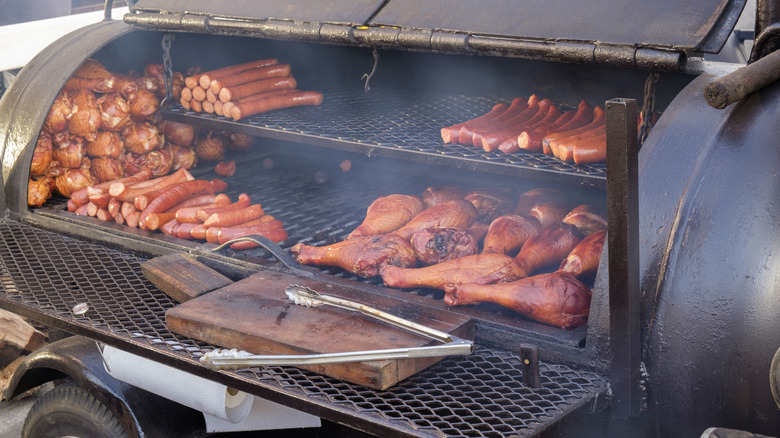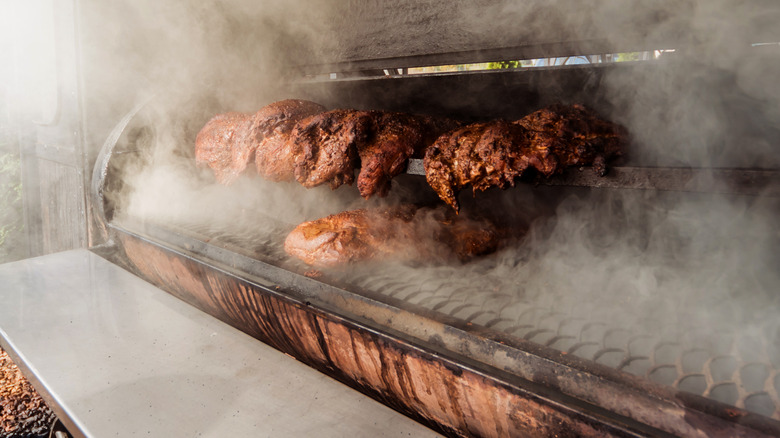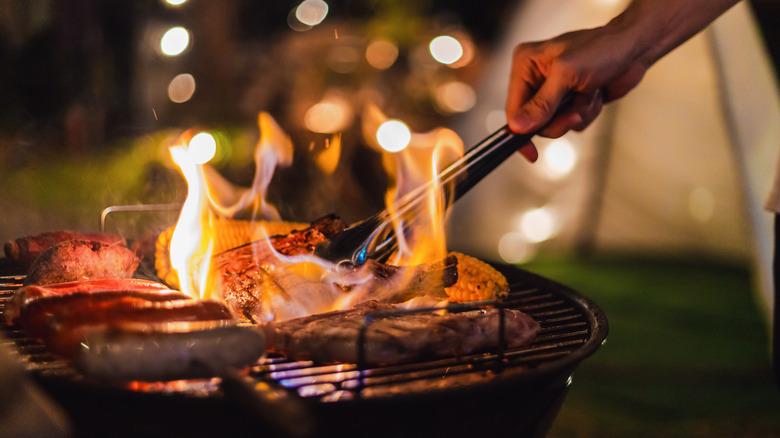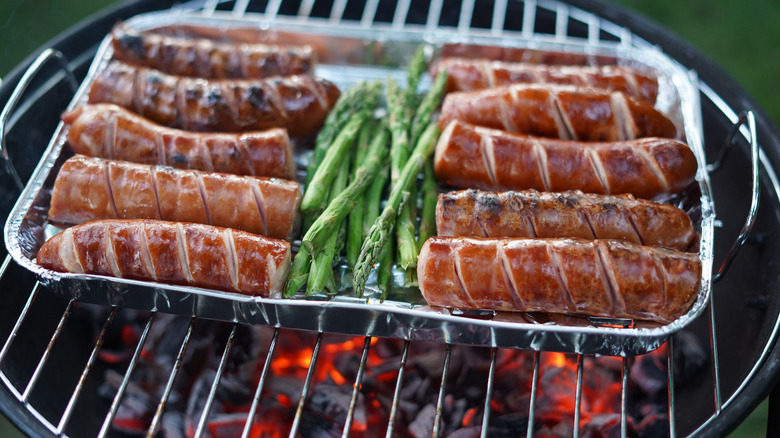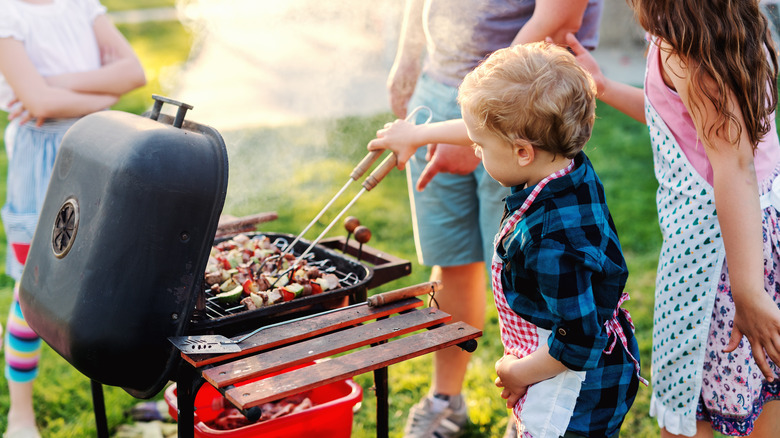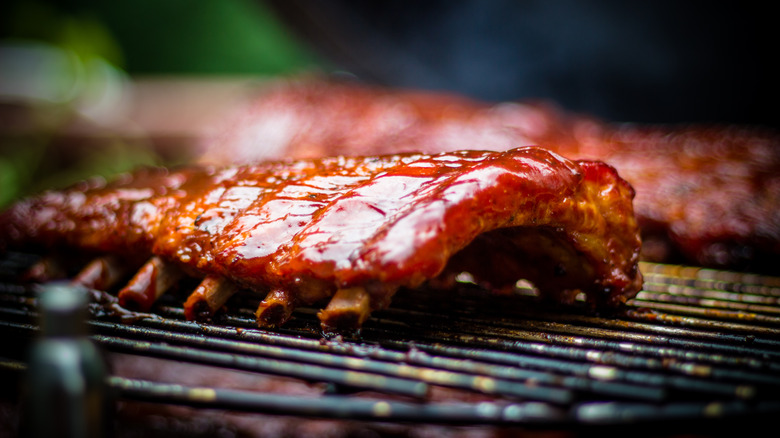The Real Difference Between Smoked And Grilled Meat
There's nothing quite like setting up your grill and preparing it for an outdoor feast. Even though the act of smoking meats is often included in the talk of grilling, there is a significant difference between the two methods. Preparation, equipment, effort, time, and flavor are just some of the characteristics that are distinct when it comes to choosing to grill or smoke meat.
Depending on the meat you plan to prepare, one of the techniques might be better suited in certain scenarios. As well, the overall style of the dish you are making can be a big influence on your decision — do you plan to cover the meat with a strong rub that will withstand the flame or do you plan to serve it with a sauce after it cooks?
Though it may sound redundant, it's important to note that smoking meat infuses it with smoky flavor as it cooks at a lower temperature over a longer period of time. Meanwhile, meat on a grill takes on more of the flavors of char from the direct high heat that cooks the protein much more quickly. There are plenty of other factors to consider when deciding which method to use.
While you may be limited by equipment, if you're looking to upgrade, a combined grill and smoker apparatus is increasingly common to find. And if you want to keep it simple but like having options, Family Handyman advises to opt for a charcoal grill with a sealable lid, which can act as a cross between a grill and smoker.
How do you smoke meat?
Spoon University describes smoking as a form of preserving and cooking food using (naturally) smoke combined with low, indirect heat that's contained in an enclosed space. While this was once a practical method — meat had to be preserved before refrigerators existed — nowadays people usually turn to smoking for the flavor and tenderness imparted in the process. Spoon University further explains that when burning wood is used as the source of the heat, the smoke creates different flavors depending on the type of wood used: for example, mesquite, hickory, or apple. The site adds that electric, gas, and charcoal smokers are also common, and all ensure that a consistent temperature is maintained throughout the process for even cooking.
There's also variations within the term. For example, food is considered cold-smoked from 68-86 degrees Fahrenheit, and hot-smoked up to 250 degrees Fahrenheit, according to Food Lion. When cold smoking, the site explains that the meat must first be cured using brine or salt. Meanwhile, hot smoking occurs at higher heat over a longer time (it can be an all-day affair), effectively super cooking the meat, so it can also benefit from a dry rub for added flavor (via Spoon University). Besides just adding flavor from the smoke and wood, the lengthy process of smoking causes collagen and fat to break down and melt, resulting in juicy, tender meat, explains Napoleon Grills.
How do you grill meat?
On the other side of the spectrum, grilling involves using high heat for a shorter duration, according to Spoon University. The site explains that meat is placed on a grate over the heat source, which comes from charcoal, wood, or gas. Food Lion describes the process of direct grilling, which is when the flame is immediately beneath the grate, cooking your meat between 400 and 550 degrees Fahrenheit in no time. Alternatively, the source also explains that indirect grilling uses heat between 190 and 300 degrees Fahrenheit, and needs a longer period to cook larger pieces of meat. When grilling, the aim is to get a lot of heat to each side of the protein in order to sear it and create a crust, which Food Fire Friends notes is important for retaining moisture as it cooks.
Grills come in all sorts of styles, all of which require more or less involvement. Taste of Home explains that gas grills use propane to heat up quickly and are ready in no time. You can easily set the temperature, and alter it depending on your needs, using a simple dial. Meanwhile, charcoal-burning grills require you to light coals and wait for them to slowly heat up. Since you're working with fire, it can be more difficult to monitor the actual heat and requires more attention to avoid burning your food. Then again, nothing compares to the taste of smoky charred meat straight from a coal-burning grill.
Is one method more nutritious?
Both smoking and grilling add plenty of flavor to meat (and veggies too) without creating extra fat. Unfortunately, the two techniques have sometimes been linked to possible carcinogens released during cooking. Time Magazine points out that many of the results are hard to separate from other factors, though, such as whether people who eat lots of grilled and smoked meats also consume more processed foods.
Nevertheless, Moffitt Cancer Center spoke with epidemiologist Dr. Stephanie Schmit who explained that darkened, charred meat and smoky flavors contain carcinogenic compounds. According to Totally Smokin', it appears that the combination of high heat, meat, and animal fat act together to create these compounds. But, the source says, that when meat is smoked more slowly at lower temperatures, the formation of these potential toxins is less likely.
Besides the temperature and intensity of the heat, the source is also significant. A study in the Journal of Food Chemistry found that certain types of wood (poplar and hickory) produce less detrimental compounds compared with others (notably beech). Additionally, Livestrong indicates that Zeolite filters used in cars could eliminate some of the carcinogenic compounds from smokers, thereby making them a healthier option.
To reduce possible negative effects, Dr. Schmit recommends keeping your grill clean, cooking meat quickly, avoiding the charred bits, and limiting overall consumption (via Moffitt Cancer Center). Cancer researcher Dr. Freedland also tells Time Magazine that incorporating herbs and spices into marinades, and wrapping the meat in tin foil are other good ways to reduce the risk.
Is grilling or smoking meat easier?
When it comes to the simpler cooking method, The Spruce Eats points out that smoking requires more skill to perfect, so beginners might want to start with grilling. Since smoking meat takes a long time, it also requires far more vigilance. Spoon University points out that, unless you're using an electric smoker with regulated temperature controls, you have to ensure the wood or charcoal are burning consistently. If the temperature rises too high, it could cook the exterior of the meat, making it impossible for the smoke to continue cooking the interior, adds The Spruce Eats. Considering the process occurs in a closed chamber, it is more difficult to keep an eye on the meat without disturbing the temperature every time you open it, too. If you've already mastered the technique and have plenty of time, then smoking is the best way to build complex flavor and a tender melt-in-your-mouth texture.
But, for a quick approach that will have you eating in no time, the definite choice is grilling. Since the meat is cooked at such high heat, The Spruce Eats explains that grilling is done much faster to maintain a juicy, tender consistency. Even though grilling is quicker, if you are using direct heat from the flame, you also have to be attentive or you will end up with completely blackened, inedible meat. Food should be regularly moved around the grill as well to avoid burning it, and Spoon University recommends using a trusty meat thermometer to know when it's ready.
Are some meats better smoked or grilled?
Spoon University specifies that large pieces of meat definitely benefit from a long and slow cook time, making them ideal candidates for a smoker. If you plan to brine your meat or give it a dry rub, smoking will really help the flavors infuse during the cooking time. As well, using smoke from different types of woods imparts their own taste, which may pair better with more flavorful meats. Food Lion suggests smoking chicken wings, pork shoulder, brisket, and ham. Since smoking takes far longer, use fattier cuts of meat to avoid them drying out over time, adds Char-Broil.
On the other hand, The Spruce Eats recommends direct grilling small pieces of tender meat like steaks, and doing so quickly at high heat. Chicken breasts, pork chops, and fish filets are also cuts that do well with direct heat, according to Food Lion. Meanwhile, the outlet recommends indirect grilling for larger hunks of meat such as brisket, whole chickens, ribs, and pork shoulders.
When deciding whether you'll be smoking or grilling, look at the size and fat content of the meat as well as the flavor profile you're aiming for to make the right decision. If you opt for smoking, make sure you have sufficient time — it's not a process that can be rushed!
